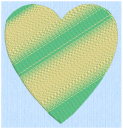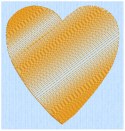Density of stitching may be set from 2 to 40, except for Pattern Fills ![]() , Spiral Fills
, Spiral Fills ![]() , Satin Column
, Satin Column ![]() and Satin Area
and Satin Area ![]() (2 to 80), and Richelieu Bars
(2 to 80), and Richelieu Bars ![]() and Satin Line
and Satin Line ![]() (2 to 15).
(2 to 15).
|
|
|
|
|
|
Pattern Fill Area with Multicolor Gradient |
Pattern Fill Area with Gradient Density Fill |
Pattern ![]() and Spiral
and Spiral ![]() Fill areas and Satin Columns
Fill areas and Satin Columns ![]() may also have density gradients, or variable multi-density. The higher the number, the farther apart the stitches and the fewer stitches are produced. Pattern fills and Satin Columns may also have multicolor gradient density.
may also have density gradients, or variable multi-density. The higher the number, the farther apart the stitches and the fewer stitches are produced. Pattern fills and Satin Columns may also have multicolor gradient density.
Embroidery on thicker fabrics usually looks better with more stitch coverage, or a low density setting. Choose a low value such as 2 or 3 for heavy knit fabrics, a higher value such as 5 or 6 for a light material like linen or satin.


